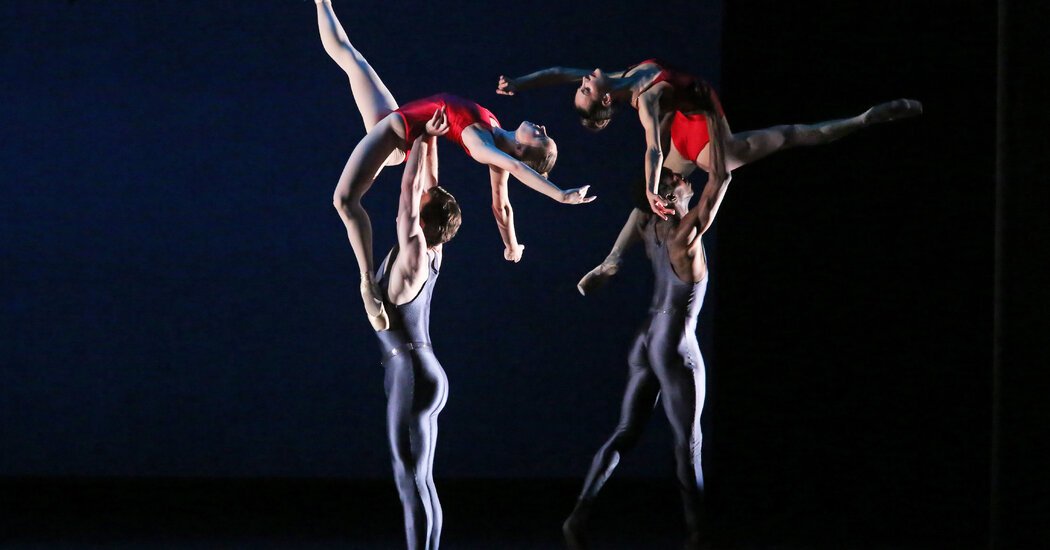[ad_1]
American Ballet Theater opened its fall season on a high note: Alexei Ratmansky’s “Piano Concerto No. 1,” the final dance in his moving, sometimes transcendent “Shostakovich Trilogy.” But two more ballets remained to be seen: The mawkish, melodramatic “Petite Mort” by Jiri Kylian and the parade of tutus and tendus that make up “Études” by Harald Lander.
The program, part of the first New York season created by the company’s artistic director, Susan Jaffe, gradually lost steam. “Petite Mort” (1991) is flimsier than ever. “Études” inches along its unmusical path, weighed down by inertia until the last few minutes, in which the stage displays fireworks in the form of pyrotechnic tricks. (By this point, it feels like you’ve been tricked into caring.) Devon Teuscher’s clean, classical elegance lent the overlong work a boost of grace and energy, but the ballet, created in 1948, is hardly a good time capsule. It’s more like walking backward — in slow motion.
There will be better programs in the days to come, particularly the pairing of George Balanchine’s “Ballet Imperial” with Frederick Ashton’s “The Dream.” Was the first one, which opened on Wednesday at Lincoln Center, meant as a teaching moment for the dancers? “Études” in particular highlights technique, the building blocks of classroom training. In a program note, Lander describes his ballet as “an expression of myself, and of my thoughts on dance. Dancing is not just delivering some steps to the audience.”
But “Études,” last performed by Ballet Theater in 2008, kind of is. In previous years at Ballet Theater, “Études” opened with five children — adorably — demonstrating the five positions of ballet; this time, in an alternate version, a single dancer, Léa Fleytoux, did the honors. (This is now the preferred option by the Lander estate.)
In “Études,” set to Knudage Riisager’s adaptation and orchestration of Czerny’s piano études, the dancers have to supply the radiance. Of the male leads, Joo Won Ahn showed hints of grandeur, though never enough to propel his onstage persona or technique to new territory. The ever-rising Jake Roxander was his sparkling self, offering robust leaps and turns that spun silkily to the softest of finishes. Earlier in the program, performing another debut in “Piano Concerto,” his landings were jarringly noisy; he transformed in the space of two hours.
Kylian’s ”Petite Mort,” or “Little Death” in French, is named after the euphemism for orgasm and set to two piano concertos by Mozart. (It was created for Nederlands Dans Theater to celebrate the second centenary of the composer’s death.) This dance, with its crisp unison passages and slithery pas de deux, is all about building tension.
It seemed that the cast of six men and six women needed more rehearsal time; imprecision here, as well as in “Études,” was hard to ignore. But worse is the choreography’s coolly aggressive approach that reads more sinister than stylish as it opens with the men and their swords, which they use to slash the air. When they pair up with the women — more conquests than partners — legs are spread, stretched long or bent like frogs’, hips are thrust and knees are pressed into the chest as a base for mounting.
Props are key, most embarrassingly the swords with their not-so-subtle hint at penetration. There is also a billowing piece of dark fabric, manipulated by the dancers, to introduce new scenes; and free-standing gowns that glide across the stage making it easy for the women to, say, slip out of their dresses. It’s Mummenschanz after dark.
There was nothing stale, though, about “Piano Concerto,” made for the company in 2013. Set against George Tsypin’s backdrop of red stars and broken sickles, which float in the air like relics of Soviet propaganda, the ballet is lively and bright with hidden pockets of desolation. Dancers, wearing Keso Dekker’s striking two tone unitards — the lead women are in shiny crimson leotards — cross the stage in unison groups, their sweet swagger growing to fits of lightning rapidity. They fly through the air in bounding leaps; spins are space-eating and ferocious.
But the speed is there for a reason. The dancers seem to be searching for freedom, searching to escape an unseen boundary. Shadowy moments, notably in duets for the two couples, cast doubt over the apparent fun. Christine Shevchenko with Calvin Royal III, and Skylar Brandt with Roxander, perform a double pas de deux that creates a hushed quality over the darkened stage as, in unison, they lift or bow toward one another in ways that feel like the private whispers of lovers.
Shevchenko and Royal are sleek and lustrous; especially soulful are Brandt and Roxander as they prolong their final parting until he sits on the stage with one arm wrapped around his knee as if the air has been sucked out of him. Never fear — soon the jovial spirit picks back up, leading the way to a rollicking finale. “Piano Concerto,” like many Ratmansky ballets, is full of attack and speed, but it’s the mysteries hidden within them — the way they waver between lightness and darkness — that make repeated viewings necessary. And this one was more than necessary. The program, at least, started with a bang.
American Ballet Theater
Performances continue through Oct. 29 at David H. Koch Theater, Lincoln Center, abt.org.
[ad_2]
